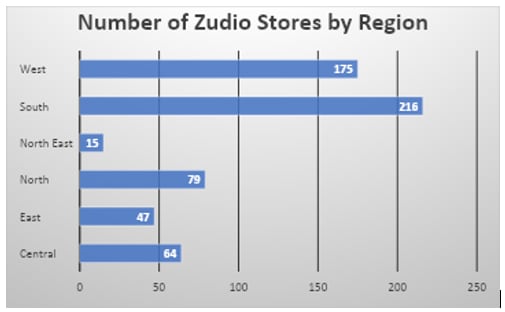How Zudio made profitability trendy
Value fashion in India has a new playbook — Zudio's story is one of smart strategy and consistent execution


The secret to Zudio"s remarkable success in scale and profitability lies in its effective application of the blue ocean strategy. It is particularly interesting that Noel Tata, Chairman of Tata Trusts and Trent, studied at INSEAD in Fontainebleau, France — the same institution where the concept"s authors, Chan Kim and Renée Mauborgne, are based.
Operating in organised retail is challenging. Customers have multiple options and face little-to-no switching costs, vendors enjoy strong bargaining power, and intense lateral competition comes from other industry players. The rise of e-commerce has further exacerbated industry profitability.

Source: Zudio website
Zudio recognised these industry dynamics and addressed them at their core. The blue ocean strategy advocates using the ERRC Grid to reduce costs and simultaneously enhance value for the end user.
The "ER" aspect focuses on cost reduction — eliminating and reducing activities typically considered essential in the industry, thereby substantially lowering the operating cost structure compared to the industry average. Zudio operates exclusively through offline stores and does not spend on advertising or marketing, eliminating two major cost drivers that are standard to its competitors. All products are private label, eliminating external sourcing and minimising supplier bargaining power. Product variety is not seasonal, and inventory turnover is exceptionally fast — approximately every 15 days — resulting in lower inventory costs.
Store design elements, such as Belgian glass for mirrors that do not significantly enhance user experience, are excluded. Its franchise-owned-company-operated (FOCO) model—unlike the company-owned-company-operated (COCO) or franchise-owned-franchise-operated (FOFO) models—helps keep operational costs low. The materials used, largely polyester or cotton blend, also help cut costs. There are no discounts everything is sold at MRP, with the exception of biannual sales.
The "RC" aspect relates to raising and creating value for the end user — either above the industry standard or in ways not yet addressed by the industry. Despite using polyester or cotton blend materials, Zudio"s clothes provide a premium feel unmatched by other value retailers. Store ambience is similarly elevated, providing a premium shopping experience regardless of location.
Zudio stores have become aspirational shopping destinations—elegant and trendy. The "Everything 999" proposition is particularly attractive. It offers premium garments in high-end settings for under a thousand rupees, appealing to price-sensitive shoppers who also seek quality.
Zudio has also captured non-customers — a core goal of the blue ocean strategy — particularly in Tier 3 and 4 towns. First came the "soon-to-be customers": those previously shopping at other value retailers who switched to Zudio for its superior value. Next were those who had tried value retail but never returned, put off by poor quality, aspirational appeal, or outdated designs. Zudio resolved these pain points, bringing them back into the value retail segment. Lastly, there were customers — from Tier 3 and 4 towns or Gen Z — who had never been targeted with such a compelling value proposition. Thanks to Zudio, they now enjoy a high-quality retail experience.
With its lower-than-industry-average operating costs and higher-than-industry-average user experience, a blue ocean strategy generates high profitability. However, with competitors like Reliance and Shoppers Stop entering the value retail segment, Trent must once again reinvent — finding new ways to reduce costs and increase customer value to maintain its competitive edge. Sustaining a blue ocean requires as much effort as creating one. Without continuous innovation, rivals may imitate the model, turning the market into a red ocean where profitability quickly erodes. This presents a major strategic challenge for Trent, as rivals will soon go toe-to-toe with Zudio across its geographical footprint.
About the authors: Kapil Khandeparkar is an Associate Professor of Marketing at the S.P. Jain Institute of Management and Research (SPJIMR), and Rohit Prabhudesai is an Associate Professor of Strategy and Consulting at the Goa Institute of Management.
Views are personal.
First Published: May 05, 2025, 14:43
Subscribe Now